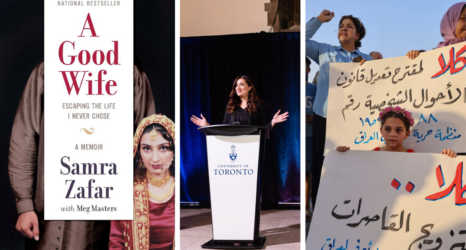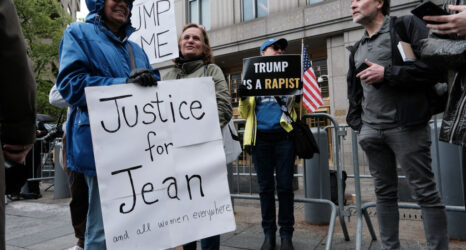In April, a doctor in Michigan was arrested for performing female genital mutilation/cutting (FGM/C) on girls. Various news outlets have since reached out to survivors, hoping to speak with them and share their stories to show that FGM/C does occur in the United States. I have been one of those voices on the media’s lips. I’m a survivor and advocate, and for nine years I have worked to shed light on how prevalent this form of violence is around the globe.
But these news outlets haven’t recognized another fact about me: Before cofounding Sahiyo, an organization that raises awareness of FGM/C through storytelling methods, I worked in the anti-domestic violence field.
At W.O.M.A.N., Inc., an organization I worked with in San Francisco, I learned to support domestic violence survivors by meeting them “where they are at.” We recognized that survivors’ had their own agency, and as advocates we would not push someone experiencing abuse into taking actions they might not be ready to engage in—including leaving their abusive partner or reporting the abuse to the police. In part, this was because the root cause of domestic violence involved power and control, and that abusive acts—whether they be physical, emotional, psychological or sexual—were carried out by the abuser to hold power and control over someone they were in an intimate or familial relationship with. Since a survivor’s agency had been taken away from them, we ensured they were the ones making the decisions if they connected with us for support.
With FGM/C, I have learned that regardless of the reason for the continuation of it generation after generation–religion, hygiene, culture, sexuality–the root cause of FGM/C is also connected to controlling another person. Most often, that person is a girl—one who is too young to consent to what is happening to her.
From working in both fields, it is difficult for me not to see the many parallels between the anti-domestic violence movement and the anti-FGM/C movement. I can’t help but find the similarities somewhat fascinating, as well as disappointing. Both forms of gender violence are centuries old. Both cross racial, ethnic and religious lines. Both have been justified, and continue to be justified, by religious and cultural roots. Both are also learned behaviors—meaning we know that people pick up these violent behaviors through observation, experience, reinforcement, culture, family and community in their childhoods.
And both movements to end these forms of violence have had opponents who have sought to disempower the women who spoke against them.
The anti-domestic violence movement in the United States took root during the second wave of feminism in the 1970s, when women began speaking publicly about spousal abuse. At the time, if a man was arrested for hitting his wife, it was viewed as a “lover’s quarrel” and a private matter. In fact, in 1968, the Harris poll interviewed 1,176 American adults and found that 20 percent approved of slapping one’s spouse on “appropriate occasions.” Feminists of that era fought against those notions, making domestic violence a public matter—not an individual woman’s problem, but a social problem—that no matter who it occurred between was unacceptable.
When these women initially spoke up, they were accused of rattling the cage, of breaking up marriages, of sticking their noises in where they didn’t belong. In a Ted Talk, Esta Soler, Founder of Futures Without Violence, recalled that when she lobbied for legislation to outlaw domestic violence in 1984, one politician called the bill the “Take the Fun Out of Marriage Act.”
Today, with the anti-FGM/C movement in the United States, once again a form of gender violence is being taken out from the darkness of the private sphere into the light of public discourse. As awareness of FGM/C grows, so do the challenges in speaking out. Anti-FGM/C advocates, for one, are often condemned by members within their own communities who are steadfast that the practice must be continued for the good of the girl. One other challenge has also emerged: The utilization of FGM/C, easily seen by those in the U.S. as a “foreign” issue, to divide feminists who are fighting against myriad systems of oppression and violence.
In April, Fox News did a segment attacking so-called celebrity feminists for failing to speak loudly on the issue of female genital mutilation and cutting, contrasting their “silence” on the issue with their vocal support for the January 2st Women’s Marches. On the screen they flashed the words “THE REAL WAR ON WOMEN.” Another article I came across implied that since publications such as Slate or Salon had yet to write a piece on FGM/C,there must be something deficient in their “feminist” movement. Anti-FGM/C advocates were being confronted by sources who wanted to criticize feminism—and the very women who may have inspired anti-FGM/C advocates like myself to garner the strength needed to speak up about the violence we see occurring in our communities.
It’s true that not every feminist in the world is speaking out against FGC. But plenty of them are. I am. And I say that we should shift focus and support the women who are speaking up instead of tearing down the ones who aren’t. During the 1970s, feminists like Esta Solar stood up to make their voices heard because they wanted to acknowledge what was happening in their families and in their communities. Today, survivors of FGM/C hope to do the same by sharing their stories.
The U.S. has a long history of attacking feminism when it comes to speaking about violence against women, but it is vital that we advocates do not let opponents of feminism tear down women’s movements with their claims that feminists are not concerned with one specific form of gender violence. Of course they are. The core belief of feminism entails ensuring there is an equality between the genders.
Instead of focusing on how feminism is failing when it comes to FGM/C in the U.S., let’s encourage critics to focus on the girls, the survivors, to help them tell their stories and let them become the feminist voices of change.





